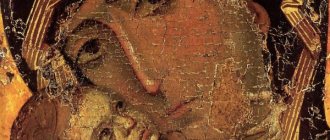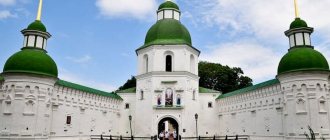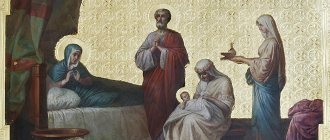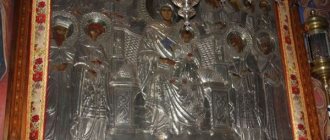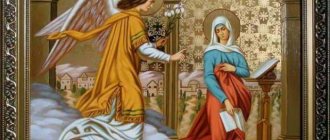Andrey Rublev Rublev, Andrey (1360s-1430)
Have you ever been to the great Tretyakov Gallery? No, go ahead. And if there were, then your inspection probably began with the art of the ancient Russians - icon painting. And among them one cannot help but notice the most famous icon - the “Trinity”. This great masterpiece was performed by monk Andrei Rublev. There are a number of other icons, but there are very few of them. You can’t remove his painting from the temple of the Moscow Kremlin.
Large collection of icons, incl. many icons of Andrei Rublev
In general, very little is known about Andrei Rublev. It is unknown when he was born, but the exact date of his death is known. It is unknown how many works he managed to create throughout his life and how many of them perished before reaching us. Art historians cannot specifically attribute many icons to his handiwork. And here they can be understood, because he did most of his work together with someone else. And therefore, confusion may arise, and as a result, the wrong recipient of the work.
They only admit that he probably lived in the Trinity Monastery, where he became a monk. However, the first mention of it is known in 1405. In this reference it was written that at that very time he was decorating the Annunciation Cathedral in the Moscow Kremlin with icons and frescoes, and not alone, but with Theophan the Greek and Prokhor from Gorodets.
His name appears at the very end of this mention, since he was the youngest both in rank and age. He also worked in Vladimir in 1408 together with Daniil Cherny. What they did in the Vladimir Assumption Cathedral is now kept in the Tretyakov Gallery, and the most valuable of the icons.
They also work with Daniil Cherny in the Church of the Holy Trinity in the Trinity Monastery. For three years they worked on frescoes and icons. Soon Cherny dies and then Andrei heads back to Moscow, to the Andronikov Monastery. There, presumably around 1428, he created his legendary icon of the Savior, which was located in the Church of the Savior on the territory of the monastery.
I repeat, not much has survived, but what remains for us, descendants, is quite enough to understand what Rublev’s art was like. Almost all of his works are now kept in the Tretyakov Gallery. His most famous work, “The Trinity,” was for a long time located above the tomb of Sergius of Radonezh. Now they are trying to preserve it and try not to spoil it. That’s why this work is kept under glass, and what’s more, a special microclimate has been created inside the frame, which is better not to disturb, otherwise the consequences will be inevitable.
In his art, he combined two traditions - asceticism and the classical harmony of the Byzantine manner. His works seem somehow soft, somehow welcoming. This is clearly noticeable if you compare the works of Byzantine masters and what Rublev did. The plots seem to be the same, but the craftsmanship is different and completely different. Goodness, it is goodness in the faces that always attracts us in his works.
The monk died in the same Andronikov monastery on January 29, 1430. The master died, but his works continued to live for him. Many of his icons were either completely or partially restored in the 20th century alone. “Saved” it was discovered by accident by restaurateurs in Vladimir. At that time, this discovery caused a lot of noise. In the early 70s of the 20th century, another Andrei by the name of Tarkovsky directed the film “Andrei Rublev” or “The Passion of Andrei”. Tarkovsky made a unique film that tells us about Rublev and the time in which he lives and shows the difference between the world of art and the world of reality. The film turned out to be so strong in its content that Soviet bureaucrats banned it almost immediately and put it on the shelf for many years.
A lot has been written and spoken about Andrei Rublev. Moreover, he was canonized in 1988 and his day began to be celebrated.
Alexey Vasin
Technique of Rublev icon painting
Andrey Rublev. The Ascension of Christ (fragment). 1408. State Tretyakov Gallery, Moscow
Andrey Rublev. The Last Judgment: The throne prepared. The Mother of God, John the Baptist, Adam, Eve, angels, apostles Peter and Paul (fragment). 1408. Assumption Cathedral, Vladimir
Andrey Rublev. Prophet Zephaniah (fragment). 1408. State Russian Museum, St. Petersburg
Early examples of Rublev icon painting correspond to the general rules followed by the masters of that time. On Orthodox images of the 14th–15th centuries, it was customary to depict stern and ascetic faces with characteristic Byzantine features: large eyes, a high forehead, a straight nose and thin lips. The craftsmen used mostly restrained, dark colors: dark red, brown, ocher-yellow.
The icon painter and restorer of the early twentieth century, Vasily Guryanov, described Rublev’s early works as follows: “... the faces are painted in thin layers, observing an extreme sequence in the transition from illuminated to unlit places, they look definitely greenish in the shadows and are modeled with brown (“dark”) ocher without marks, i.e. i.e. without strokes in the brightest places to indicate highlights with white paint; In accordance with the faces, the figures are also poorly modeled, and the outline is indicated only by a thin description.”
In his later works, Andrei Rublev moved away from the canons of icon painting. He often used light, light colors - golden yellow, light blue, pink. The faces on his icons acquired Slavic features - a soft, rounded oval face, blond hair and eyes, a wide forehead. The expressions on their faces also changed: Rublev’s angels and saints became joyful, spiritual, and barely noticeable smiles appeared on some faces. “Andrei Rublev revived the ancient principles of composition, rhythm, proportions, harmony, relying mainly on his artistic intuition,” wrote art critic Mikhail Alpatov.
The icon painter often used the technique of glazing - on top of the main layer of paint he applied another, translucent one, on which he painted fine details. This technique made it possible to create smooth lines and smooth out color transitions.
Prayers to the Most Holy Theotokos in front of Her Icon “Vladimir”
Troparion, tone 4
Today the most glorious city of Moscow is shining brightly, / as the dawn of the sun has received, O Lady, Your miraculous icon, / to which now we flow and pray to You we cry out to You: / O, most wonderful Lady Theotokos, / pray to You, our incarnate God, / may He deliver the city this and all Christian cities and countries are unharmed from all the slander of the enemy, // and our souls will be saved by the Merciful.
Kontakion, tone 8
To the chosen victorious Voivode, / as those who were delivered from the evil ones by the coming of Your honorable image, / Lady Theotokos, / we brightly celebrate the celebration of Your meeting and usually call You: // Rejoice, Unmarried Bride.
History of creation
The prototype of this icon was the mysterious appearance of the Holy Trinity in the form of three travelers to Abraham and Sarah under the oak tree of Mamre.
Abraham and his wife Sarah were entertaining three angels in the shade of an oak tree when the man realized that the angels were the personification of God in three persons.
In Antarctica, the snow changed color and turned into green and crimson
For inflammation and a few more reasons to include spicy foods in your diet
KAMAZ and alternative energy sources: development of hydrogen vehicles is underway
There are many different images of the Holy Trinity in the church. But the icon that defines the very essence of Trinity Day invariably depicts this celebration in the form of three angels.
How the Vladimir Icon of the Mother of God came to Rus'
This icon was in Jerusalem until 450, and then was transferred to Constantinople. In the 12th century (1131), Patriarch Luke Chrysoverg of Constantinople sent a copy (copy) of the Vladimir Icon of the Mother of God to the Grand Duke of Kyiv Yuri Dolgoruky.
Icon of the Mother of God of Vladimir
Yuri Dolgoruky placed the icon in the Vyshgorod nunnery. Ancient Rus' adopted Orthodoxy from Byzantium, so the Vladimir icon became a kind of symbol of the perception of Truth. From this moment on, the history of Rus' is connected with the history of the miraculous icon.
When the icon began to be called Vladimir
The village of Vyshgorod was inherited by the son of Yuri Dolgoruky, Andrei Bogolyubsky. However, Prince Andrei dreamed of returning to the place of his birth, that is, to the Rostov-Suzdal land and establishing a new capital of North-Eastern Rus' there in Vladimir.
Such a responsible undertaking could not be started without help from above. Therefore, Prince Andrei, being a pious man, decided to enlist the help of the Mother of God.
At this time, a rumor reached the prince that the icon of the Most Holy Theotokos, located in the Vyshgorod nunnery, moved from its place three times. This miracle was accepted by Prince Andrei as a sign that the Mother of God had determined another place for Her image. Therefore, Andrei Bogolyubsky decided to take the miraculous icon with him, making the Most Holy Theotokos the Intercessor and Patroness of North-Eastern Rus'.
This was in 1155. Having prayed before the icon of the Most Holy Theotokos, Andrei Bogolyubsky secretly took it out of the Vyshgorod monastery and went to the Rostov-Suzdal lands, taking with him the clergy of the monastery: the priest and clerk with their wives. First, they headed to Vladimir from Kiev along the Dnieper, rose almost to its source, and from here they headed to the Vazuza River and further to the upper reaches of the Moskva River, in order to reach the Klyazma River past Moscow, flowing to Vladimir. Such a difficult path was chosen by the prince to avoid pursuit. On the way, prayers were performed in front of the icon of the Mother of God, and the miracles exuded by the icon were recorded.
This is how the “Tale of the Miracles of the Most Pure Mother of God of the Volodymyr Icon” was born, which formed the basis for the veneration of the Mother of God in Vladimir, the new capital of North-Eastern Rus'.
For the first time we find mention of the Vladimir Icon of the Mother of God in the Laurentian Chronicle, which tells us that in 1155 the son of Prince Yuri Dolgoruky Andrei Bogolyubsky, wanting to establish a princely throne in the northern Russian lands, “Andrei left Kiev from his father in Suzdal and brought the icon of the Holy Mother of God, which was brought from Constantinople, and forged more than thirty hryvnias of gold into it, not counting silver, and precious stones, and pearls, and, having decorated it, placed it in his church in Vladimir.”
Laurentian Chronicle
Andrei Bogolyubsky ordered the construction of the golden-domed Church of the Assumption of the Blessed Virgin Mary in Vladimir. The cathedral was erected in 1158-1160 on the high bank of the Klyazma River. Prince Andrey placed the brought icon in this beautiful cathedral, like in a precious ark.
Assumption Cathedral in Vladimir
From that time on, the icon of the Most Holy Theotokos received the name Vladimir.
Main events related to the Vladimir Icon
The Vladimir Icon of the Mother of God was in Vladimir for two centuries and became famous for many miracles. In countless lists, it spread throughout the Russian Land and became the greatest shrine, which more than once saved the country from troubles and misfortunes.
Our Lady of Vladimir by Andrei Rublev
Many events in Rus' were connected with this icon. In memory of some of these events, the Russian Orthodox Church has established days of veneration of the Vladimir Icon of the Mother of God: May 21 (June 3) - in memory of the deliverance from Makhmet-Girey in 1521; June 23 (July 6) - in memory of the deliverance from Akhmat in 1480; August 26 (September 8) - in memory of the meeting of the Vladimir Icon in Moscow and the deliverance from Tamerlane in 1395.
Vladimir icon in Moscow
Beginning in 1395, the history of the Vladimir Icon of the Blessed Virgin Mary is already connected with Moscow, where it was brought to protect against the invasion of Tamerlane. In memory of this event, at the place where the Muscovites met the Vladimir Icon, the Sretensky Monastery was built in honor of their Savior.
Since then, the Vladimir Icon has been repeatedly transferred from Moscow to Vladimir, from Vladimir to Moscow. And only at the end of the 15th century it finally settled in the Assumption Cathedral of the Moscow Kremlin.
Assumption Cathedral of the Moscow Kremlin
However, the revolution of 1917 radically changed the course of our country: from Orthodox it became atheistic. The fate of the Vladimir Icon also changed: in 1918 it was given for restoration, after which it never returned to the Assumption Cathedral. In 1926, the Vladimir Icon was placed in the State Historical Museum, and in 1930 it was transferred to the State Tretyakov Gallery.
State Tretyakov Gallery
But God cannot be mocked: thanks to the efforts of the Russian Orthodox Church, in September 1999, the Vladimir Icon of the Most Holy Theotokos was transferred to the Church-Museum of St. Nicholas in Tolmachi at the State Tretyakov Gallery.
The Church of St. Nicholas in Tolmachi was built in the 17th century. In 1929, the temple was closed and transferred to the gallery for storage space. In the early 1990s, it was restored, and in 1993, services were resumed there.
St. Nicholas in Tolmachi, being an active temple, also retains museum status. It houses two great Orthodox shrines: the Vladimir Icon of the Mother of God and the Holy Trinity of St. Andrei Rublev.
Vladimir icon in the Church-Museum of St. Nicholas in Tolmachi
The Orthodox shrine is again available for public worship and veneration. Believers can again fall in prayer to the Most Holy Theotokos and bring Her their troubles and sorrows. No one will leave Her unconsoled.
